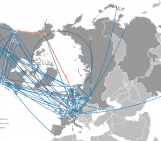
On the eve of 14 February, love and little hearts are everywhere, even trapped in lake ice!
The EGU Cryosphere blog team wishes you a happy Valentine’s Day 🙂
Behind this nice picture, there is also science
This picture was taken during a laboratory experiment that aimed to reproduce the bubbles observed in Arctic lake ice in the winter.
In this shot, we can see two types of gas bubbles in the ice. The elongated vertical bubbles are formed after the exsolution of gas at the water-ice interface. The gas present in “heart-shaped” bubbles originates from ebullition (i.e. it has been emitted as bubbles from the sediment) and it contains a large amount of methane, a significant greenhouse gas. In both cases, the gas is trapped in the ice during the downward evolution* of the freezing front but the shape and gas content of the bubbles largely depends on the velocity of the freezing front development.
The goal of this research is to better understand the origin of the methane emitted by Artic lakes and unravel the role of lake ice cover on the methane atmospheric burden.
*During the winter, the cold atmosphere cools down the water of the lake, when the freezing point is reached, a thin layer of layer of lake ice starts to form at the surface and extends downward.
Further reading/Reference
Boereboom, T., Depoorter, M., Coppens, S., and Tison, J.-L.: Gas properties of winter lake ice in Northern Sweden: implication for carbon gas release, Biogeosciences, 9, 827-838, doi:10.5194/bg-9-827-2012, 2012.
Sapart, C. J et al (in preparation).




